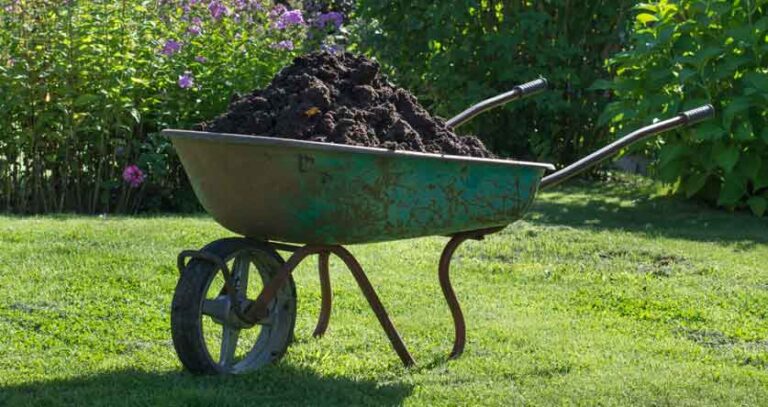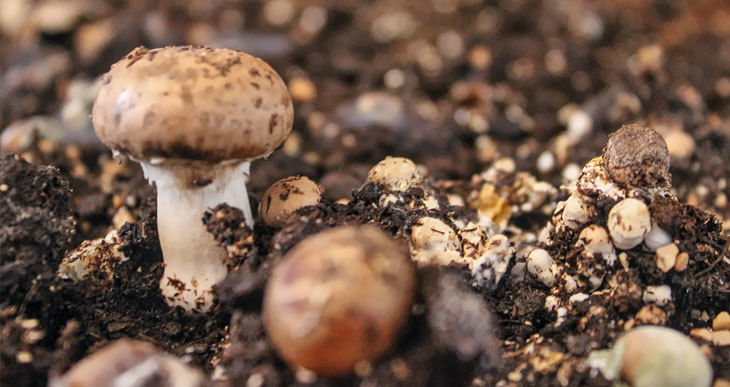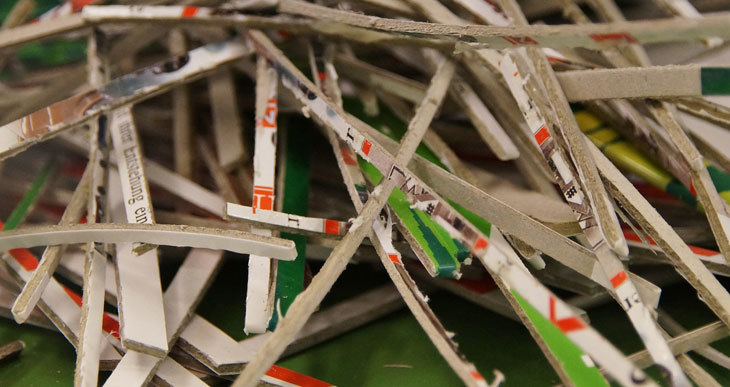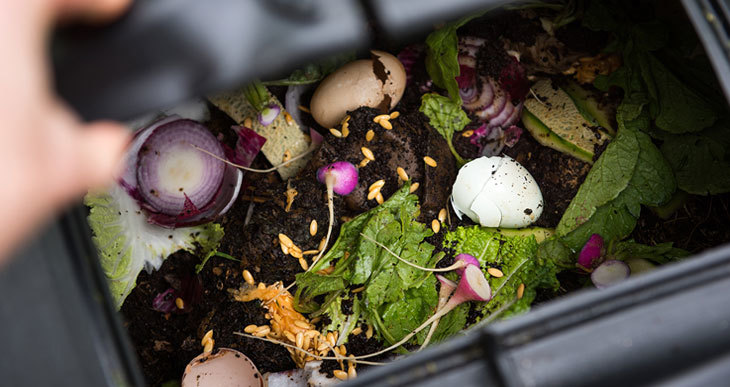How To Compost In An Apartment (No Smells No Mess Guide!)

If you think you need a yard to compost, think again. You can become a zero-waste lifestyle wizard even if you live in a studio apartment.
Just by making compost!
Food waste makes up about 25% of landfills, according to the United States Environmental Protection Agency. So, composting your kitchen scraps will earn you tons of green points and make the environment healthier.
Not only is composting in an apartment doable, but you’ve got a ton of options.
Below I’ll introduce you to the most popular indoor composting methods (and share ideas for what to do with your compost once it’s ready!).
Composting In An Apartment
You might not like the idea of actively encouraging decomposition in your home. If you’re on the squeamish side, perhaps you’re wondering whether your organic wastes will mutate into something horrifying and stink up the place.
Surprise: some composting methods create no smell and can even enhance your kitchen decor.
Follow this guide to answer all your questions and some easy indoor composting ideas…
Can You Compost In An Apartment?
Composting in an apartment is more challenging than in a garden. Still, there are several methods and devices that simplify the task. For example, indoor composting can be achieved in small spaces without foul odors or attracting pests. And many of the solutions are attractive enough to fit in with your home decor!
Many apartment-composting methods tick all these boxes – and as a bonus, they regularly gift you a soil supplement for your plants.
For example, you can do apartment composting in a bin or tumbler, worm bin, bokashi bucket, or electric composter. One of these methods is sure to fit in with your lifestyle.
And of course…
You can even get started with a simple homemade setup if you prefer!
How To Start Composting In An Apartment
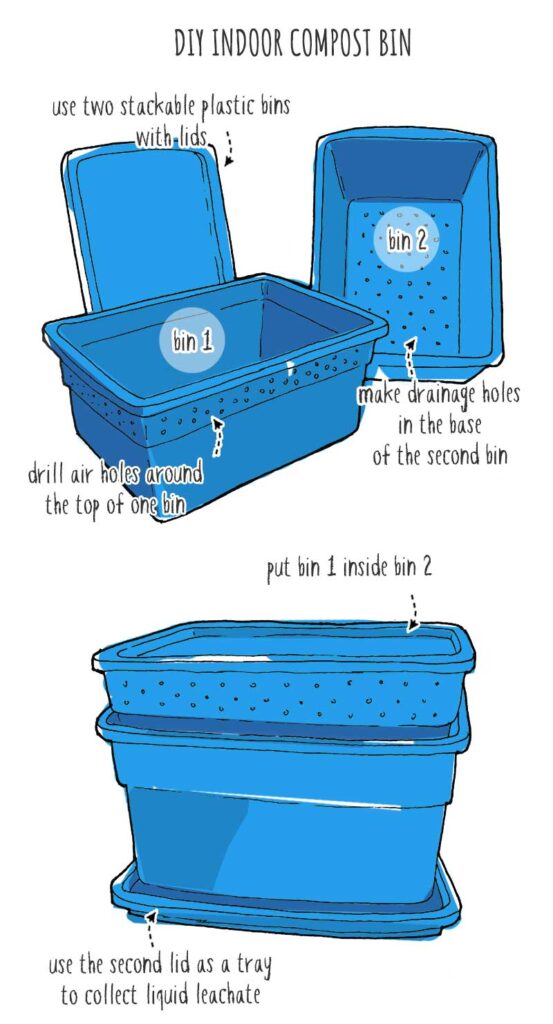
If you want to get a basic, inexpensive apartment composting system going right away, here’s how to start:
Step #1: Get two lidded plastic bins, one slightly bigger than the other. The size is up to you – anything that will fit your spare space. Tip: Keep your compost bin somewhere dark and at room temperature.
Step #2: Drill air holes around the top of the smaller bin. Space the holes about 1 inch apart.
Step #3: Drill holes into the bottom of the smaller bin for drainage. Space these evenly across the bottom part of the bin.
Step #4: Put the smaller bin inside the bigger one. Then add a few inches of soil and handfuls of shredded newspaper or sawdust to the smaller container.
Step #5: Throw your organic wastes into the inner bin. Cover the scraps with shredded newspaper, sawdust, or crumbled dry leaves. Then pop on the lid and let the composting microorganisms get to work!
Check the larger bin now and then and empty any accumulated liquid. The liquid is compost tea, a super fertilizer for your plants!
Plus, occasionally clean the larger bin to stop mold and smells in their tracks.
Your DIY bin will take months to years to fully decompose your wastes, so consider starting a new container while the first one is still breaking everything down.
Here are some pointers all newbie apartment composters must know:

- Compost organic wastes like fruit and veg scraps, houseplant trimmings, coffee grounds, tea bags, and shredded paper. However, take it easy with strong-smelling onion and water-dense melon scraps. Don’t add dairy, meat, or fats to the mix.
- Stockpile paper. Balance your wet scraps with dry ones. For every helping of kitchen scraps, add a handful of shredded paper or fall leaves (offer to rake up leaves in friends’ yards!).
- Chop up your wastes for chop-chop results. Cutting fresh produce peels into small pieces and tearing paper into strips will speed up decomposition.
- Turn your compost regularly to bring in air and spread the heat around.
How To Store Food Scraps
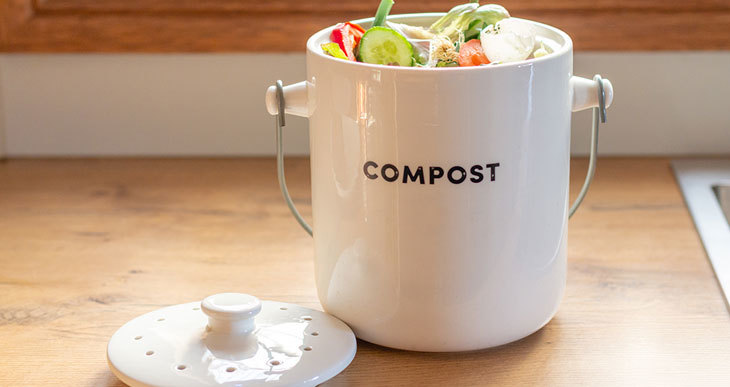
Where do you put your food scraps if you don’t want to add them to your compost immediately?
The simplest solution is to use a clean coffee can or other plastic or steel container with a tight-fitting lid (to keep potential smells sealed in and insects out). Keep the container on your kitchen counter and toss your scraps as you make them. Then empty and wash the container to keep it smelling fresh. You could even refrigerate the container for maximum odor control.
If you want to invest in something pretty and functional to hold your scraps, you’ll find many designer containers that are a pleasure to use and look at. Good picks are easy to clean and have air vents, a lid you can open with one hand, and charcoal filters to control smells.
One of the better solutions is this hanging bin that you can suspend from kitchen cabinets. (Amazon)
Another idea is to freeze your food scraps in resealable plastic bags until you’re ready to add them to your compost (or go for a reusable freezer compost bin like this one, so your composting efforts don’t add to plastic waste! – Amazon link). The freezing and thawing will speed up decomposition.
Apartment Worm Composting
For fuss-free apartment composting, add worms! Worm composting fits into eco-urban living perfectly because it’s compact, doesn’t need much maintenance and doesn’t create unpleasant smells when everything goes smoothly.
You can choose a ready-made worm bin or make your own from a plastic bin with air holes drilled in the top and drainage holes at the bottom.
The basics of using a worm bin are as follows:
- Add a layer of shredded paper, torn-up cardboard, crumbled dry leaves, or straw,
- lightly moisten the material,
- introduce your new squirmy friends (red wigglers are suitable for the job – you can order them online),
- Then feed them your kitchen scraps.
The worms will eat your food waste and turn it into nutritious castings to feed your plants.
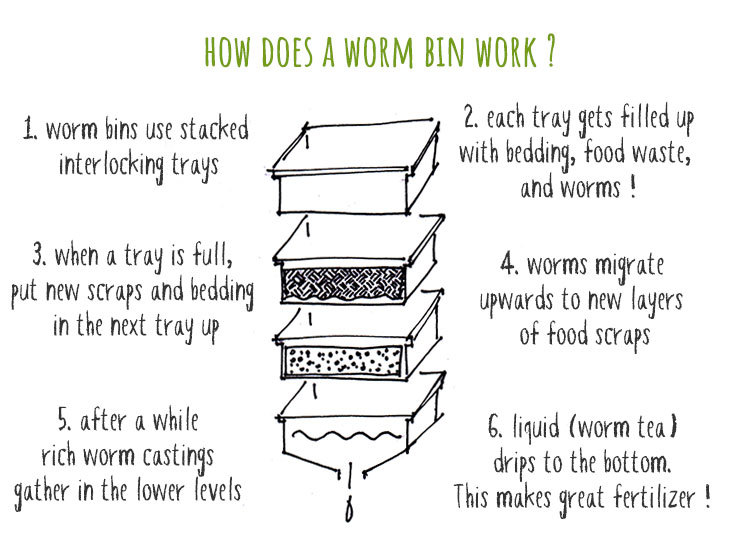
Tip: if you want an indoor worm farm that matches your decor, try one of these good-looking indoor worm composters.
Alternatively, if you have a balcony, you’ll probably have room for a larger, more advanced option like this.
How To Compost In An Apartment Without Worms
Suppose you don’t see yourself welcoming hundreds of worms into your home. In that case, there are other apartment-friendly composting methods for you to try.
Bokashi buckets and electric composters are two other popular methods that can quickly be done indoors.
Bokashi Composting In An Apartment
Bokashi composting complements apartment living because it’s suitable for small spaces and it’s an indoor method. In addition, it breaks down all food waste except bones (even meat, fats, and dairy). It does this without needing materials that might be tricky to get your hands on (like dry leaves and shredded paper).
Bokashi composting must-haves are a special bucket like this (which has a lid and spigot) and an inoculant such as bokashi bran (Amazon). Dump your food scraps into the bucket and layer some bran on top. Keep alternating layers of food scraps (as you make them) and bran till the bucket is full, then place it away from direct heat sources like sunlight and heaters.
Open the spigot every other day to let out what’s known as bokashi tea. You can dilute this nutrient-dense liquid (100 parts water to 1 part bokashi tea) and feed it to your houseplants.
After about 10 to 14 days, your food scraps will have fermented into pre-compost, which can then mature into compost to enrich the soil.
Electric Kitchen Composters
If you don’t want to share your space with any of the composting options we’ve looked at so far, perhaps a high-tech electric composter is more your sort of thing.
This modern composter is perfect for everyone who can’t get their head around letting food slowly decompose in their homes. It turns food scraps into a compost-like substance in hours! Instead of relying on microorganisms to break down organic wastes, electric composters power the process by heating and grinding the wastes for the quickest results.
There are two well-known machines available on the market. The Vitamix Foodcycler and the Lomi kitchen composter. (Amazon)
Electric composters’ downsides are that they need electricity to work, cost more than many other composters, and don’t produce living compost teeming with microorganisms.
But “gadget lovers” adore them 🙂
Composting On An Apartment Balcony
Your balcony is another ideal spot for composting! If you’re lucky enough to have this type of space, you have a wide range of options.
Three types of bins work best on balconies:
- A stationary bin. A square or rectangular bin is a space-saver.
- A compost tumbler. Tumblers take up more space than static bins, but they’re quicker.
- A worm bin. Put the bin in a shady part of your balcony in summer and bring it inside in winter.
Tumblers and bins are often reserved for homeowners who have a yard. But with a bit of research, you can find some very compact versions.
If you opt for a worm farm, give yourself room to grow with a larger model. Then, you’ll be able to process a lot more food scraps!
What To Do With Compost You Made An Apartment
So, you’ve diligently composted your food scraps and finally got earthy-smelling, crumbly, rich-brown compost. What now? Your decomposed wastes don’t need to be wasted!
Nourish your houseplants, delight your garden-owing friends with a bucketful, or donate your valuable soil supplement to nearby community gardens or farmers’ markets.
You could also store your compost in a container till you need it.


